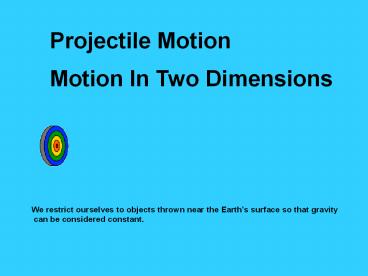Projectile Motion - PowerPoint PPT Presentation
1 / 39
Title:
Projectile Motion
Description:
Projectile Motion Motion In Two Dimensions We restrict ourselves to objects thrown near the Earth s surface so that gravity can be considered constant. – PowerPoint PPT presentation
Number of Views:357
Avg rating:3.0/5.0
Title: Projectile Motion
1
Projectile Motion Motion In Two Dimensions
We restrict ourselves to objects thrown near the
Earths surface so that gravity can be
considered constant.
2
Projectile motion refers to the motion of an
object that is thrown, or projected into the air
at an angle.
The motion of a projectile is determined only by
the objects initial velocity and gravity.
3
Projectile motion applies to sports.
4
Projectile motion applies to destructive projectil
es.
5
Projectile motion is a combination of horizontal
motion and vertical motion. The horizontal
motion of a projectile is constant because no
gravitational force acts horizontally
6
The vertical motion of a projectile is nothing
more than free fall with a constant downward
acceleration due to gravity.
7
The vertical motion of a projected object is
independent of its horizontal motion.
8
(No Transcript)
9
A projectile moves horizontally with constant
velocity while being accelerated vertically.
The result is a motion in a curved path.
10
(No Transcript)
11
The path of a projectile is called its
trajectory. The trajectory of a projectile in
free fall is a parabola.
12
A projectile, once projected, continues in motion
by its own inertia and is influenced only by the
downward force of gravity.
13
An object projected horizontally will reach the
ground in the same time as an object dropped
vertically. No matter how large the horizontal
velocity is, the downward pull of gravity is
always the same.
14
(No Transcript)
15
(No Transcript)
16
The cannonball falls the same amount of distance
as it did when it was merely dropped from rest
17
(No Transcript)
18
Horizontally launched projectile
Horizontal velocity is constant. Vertical
velocity is changing due to gravitational
acceleration..
19
Vertically launched projectile
The horizontal velocity component remains the
same size throughout the entire motion of the
cannonball.
20
Projectiles launched at different angles.
21
Sports Trivia
Maximum range is achieved if the projectile is
fired at an angle of 45 degrees with respect to
the horizontal.
22
(No Transcript)
23
(No Transcript)
24
(No Transcript)
25
In Conclusion
A projectile is any object upon which the only
force is gravity. Projectiles travel with a
parabolic trajectory due to the influence of
gravity. There are no horizontal forces acting
upon projectiles and thus no horizontal
acceleration. The horizontal velocity of a
projectile is constant. there is a vertical
acceleration caused by gravity (9.8 m/s. The
horizontal motion of a projectile is
independent of its vertical motion.
26
Test your knowledge
Suppose a snowmobile is equipped with a flare
launcher which is capable of launching a sphere
vertically. If the snowmobile is in motion and
launches the flare and maintains a constant
horizontal velocity after the launch, then where
will the flare land (neglect air resistance)?
27
(No Transcript)
28
Test your knowledge
Suppose an airplane drops a flare while it is
moving at constant horizontal speed at an
elevated height. Assuming that air resistance
is negligible, where will the flare land relative
to the plane? A. Directly below the plane.
B. Below the plane and ahead of it. C.
Below plane and behind it.
29
(No Transcript)
30
Why does the horizontal component of
a projectiles motion remain constant?
Because no force acts on it horizontally.
31
Why does the vertical component of a projectiles
motion undergo change?
Because gravity is pulling it downward.
32
How does the vertical distance a projectile falls
below an otherwise straight-line path compare
with the vertical distance it would fall from
rest in the same time?
The vertical and horizontal distances are equal.
33
A projectile is launched vertically at 100 m/s.
If air resistance can be neglected, at what speed
does it return to its initial level?
100 m/s
34
http//library.thinkquest.org/27585/lab/sim_pirate
s.html
35
There is an interesting monkey down at the zoo.
The monkey spends most of its day hanging from a
limb of a tree. The zookeeper feeds the monkey
by shooting bananas from a banana cannon to the
monkey in the tree. This particular monkey has a
habit of dropping from the tree the moment that
the banana leaves the muzzle of the cannon. The
zookeeper is faced with the dilemma of where to
aim the banana cannon in order to hit the monkey.
If the monkey lets go of the tree the moment that
the banana is fired, then where should she aim
the banana cannon?
36
To ponder this dilemma consider the following
Shoot at the monkey in a gravity free environment.
In the absence of gravity, the banana moves in a
straight line path (and does not experience any
downward acceleration) and the monkey does not
fall once he lets go of the tree.
37
Shoot at the monkey with gravity.
The banana moves in a parabolic path in the
presence of gravity. In the presence of gravity,
the monkey also accelerates downward once he lets
go of the limb. Both banana and monkey experience
the same acceleration since gravity causes all
objects to accelerate at the same rate regardless
of their mass.
Since both banana and monkey experience the same
acceleration each will fall equal amounts. The
banana misses the monkey, moving over his head as
it was originally aimed.
38
Shoot at the Monkey at a Fast Speed with Gravity
On
Since the banana left the muzzle moving very
fast, the banana reaches the monkey before the
monkey has fallen very far.
39
Shoot at the Monkey at a Fast Speed with Gravity
On
Since the banana left the muzzle moving very
slow, the banana reaches the monkey after the
monkey has fallen considerably far. In
conclusion, the key to the zookeeper's dilemma is
to aim directly at the monkey.































